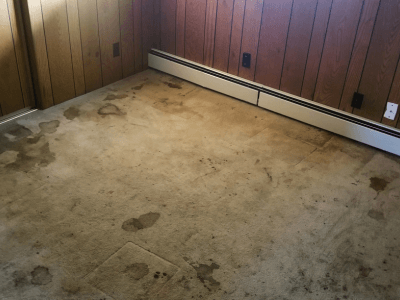
Water damage might not be the first thing you think about when it comes to home maintenance, but it can quickly turn into a nightmare for homeowners and property managers. Carpet water damage is a hidden problem that not only affects the look of your home but can also lead to serious issues if ignored.
From minor spills to major leaks, understanding how carpet water damage impacts your home is key to protecting it. When left unchecked, water damage doesn’t just leave unsightly stains—it can weaken your flooring and encourage mold growth. The longer water sits, the worse the damage becomes, making it important to act fast.
Recognizing the signs of carpet water damage and knowing when to repair or replace your carpet can save you time, money, and the hassle of future problems.
In this guide, we’ll cover:
- The signs of carpet water damage,
- When you can repair the damage and when replacement is necessary, and
- The health risks of mold in carpets due to water damage.
By the end, you’ll be equipped to make informed decisions and keep your home safe and healthy.
Signs of Carpet Water Damage
Discoloration and Stains

One of the most obvious signs of carpet water damage is discoloration. Water stains typically appear as dark patches that spread across the carpet. These stains show that water has seeped into the carpet fibers.
- Stains can vary in size and shape.
- Over time, if untreated, they may become more noticeable.
Discoloration isn’t just a cosmetic issue—it can signal deeper problems. Water-stained carpet can harbor bacteria and allergens, which pose hygiene risks. If stains persist after cleaning, it may be time to get a professional assessment to evaluate the damage.
Bad Odors
A persistent musty odor is another sign of water damage. When water gets into the carpet, it creates the perfect environment for mold and mildew, which leads to unpleasant smells.
- This odor can spread throughout your home, affecting indoor air quality.
- Ignoring the smell can lead to health issues, especially for those with allergies or respiratory conditions.
If the odor remains after cleaning, it may indicate that the water damage is deep-rooted, and more serious action is needed.
Dampness and Moisture
If your carpet feels damp to the touch or doesn’t dry within a reasonable time, it’s a clear sign of water damage.
- Prolonged dampness weakens the carpet fibers and padding. This can eventually lead to structural issues with your flooring.
Moisture trapped in carpets also encourages mold growth, which poses health risks and further damages your home’s structure. Address dampness as soon as possible to prevent lasting damage and ensure your living space is safe.
Mold in Carpet from Water Damage
Unseen Threats Beneath the Surface

Mold in carpets caused by water damage is more than just a nuisance—it’s a serious health hazard. Mold spores spread quickly, lowering indoor air quality and triggering allergy symptoms like sneezing, coughing, and eye irritation. For people with asthma or weakened immune systems, mold exposure can lead to severe respiratory issues.
What makes mold even more dangerous is that it often grows beneath the surface of the carpet, making it hard to detect at first. Regular inspections and promptly addressing any signs of water damage can help prevent mold growth and keep your home safe.
Health Risks of Mold in Carpets
Living with moldy carpets can lead to long-term health issues. Besides respiratory problems, mold exposure can cause skin irritation, headaches, and fatigue. Children and pets are especially vulnerable, which is why it’s important to take preventive steps to avoid mold.
Mold is also a sign that water damage has been a persistent issue, which could mean there’s more unseen damage in your home’s structure. A professional inspection and thorough remediation are recommended to ensure all mold is removed and any hidden moisture problems are addressed.
For more information on safely dealing with mold, check out the EPA’s guide to mold cleanup in your home.
When You Can Repair Water-Damaged Carpets
Minor Damage Scenarios
Not all water damage means your carpet needs to be replaced. If the damage is small, like a spill or minor leak, you might be able to save your carpet. The key is to act quickly—removing excess water and drying the area as soon as possible will prevent further damage and mold growth.
Using fans, dehumidifiers, and absorbent towels can help dry out minor water damage. However, it’s important to make sure the carpet is thoroughly dried to prevent any lingering moisture that could cause problems later.
Read more: Damaged by Water? Learn How to Dry Your Home Like a Pro
DIY Methods and Professional Services
If you enjoy tackling things yourself, there are several ways to handle minor water damage:
- Steam cleaning and using carpet-safe disinfectants can kill bacteria and stop mold from forming.
- Always ensure good ventilation to help speed up the drying process.
However, for more extensive damage or if you’re unsure about the severity, it’s wise to hire professional help. Companies like Complete Flood Restoration use advanced equipment to dry carpets thoroughly and address any underlying issues. Their expertise ensures your carpets are restored safely and effectively.
When You Should Replace Water-Damaged Carpet
Beyond Repair Indicators
Sometimes, water damage is too severe to fix. If your carpet has been submerged or exposed to contaminated water (such as sewage or floodwater), it’s often best to replace it. In these cases, the carpet’s integrity is compromised, and it poses significant health risks.

Water exposure over time also weakens carpet fibers and padding, making them less effective. If your carpet is fraying or has a compromised backing, replacement is the safest option.
Mold Concerns and Long-Term Exposure
If mold is present in the carpet, you need to act fast. Mold growth means the water damage has been there for a while, potentially spreading contamination. In these cases, the only solution is to remove and replace the carpet to ensure safety.
Long-term water exposure can also cause carpets to absorb contaminants that are hard to fully remove. Replacing the carpet eliminates these risks and restores both the look and function of your flooring.
Safety and Health Considerations
Your safety should always come first when dealing with water-damaged carpets. Carpets soaked in contaminated water or with visible mold are hazardous to your health. Replacing them is essential to keeping your living space safe and free from harmful pathogens.
Replacing damaged carpets also improves indoor air quality and creates a healthier home environment. Plus, it’s a chance to choose materials that are more resistant to water and mold, offering peace of mind for the future.
Conclusion
Deciding whether to repair or replace water-damaged carpets is critical to protecting your home’s safety, health, and appearance. Minor damage can often be handled with DIY methods or professional services, but severe damage, especially when mold is involved, requires prompt replacement to protect your household’s well-being.
If you’re unsure of how to handle your carpet water damage, consult Complete Flood Restoration for a professional assessment. Their expertise in water damage restoration will ensure that your home receives the care it needs, giving you peace of mind knowing your living space is safe and comfortable.
